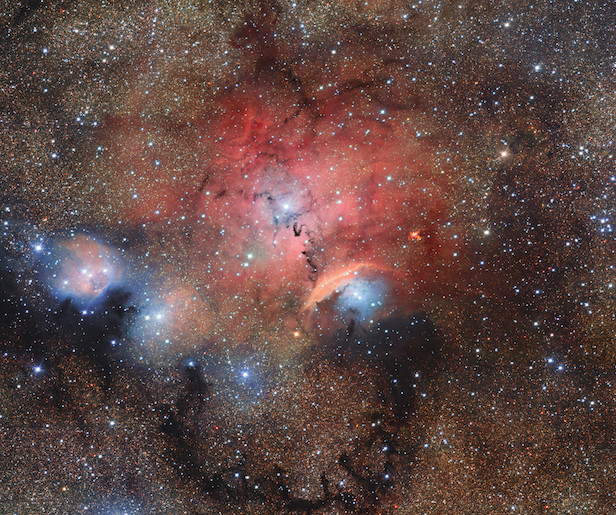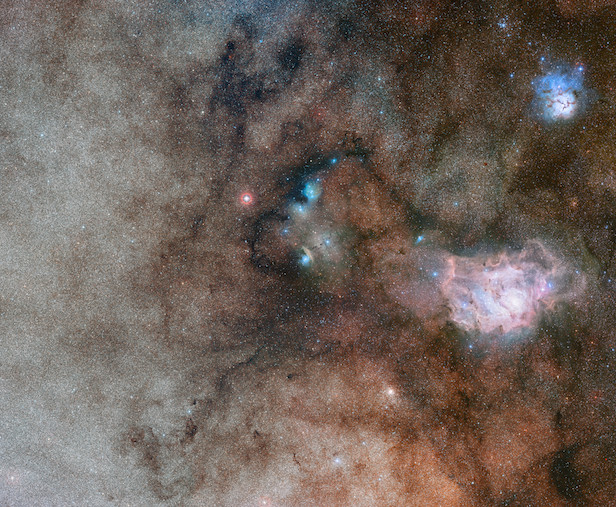New image release: Baby stars boom into view
This amazing spectacle helps astronomers understand how stellar youngsters affect their gaseous and dusty environments

Sharpless 29 is located 5,500 light years away from us in the constellation of Sagittarius. Image credit: ESO/M. Kornmesser
The European Southern Observatory (ESO)’s VLT Survey Telescope (VST) has captured a sparkling image of Sharpless 29, home to much embellishing star formation features. This sight brings together a diversity of astronomical phenomena, including young bright stars, illuminating gas and darkening dust.
Sharpless 39, also known as Sh 2-29, is part of the Sharpless catalogue that lists over 300 emission nebulae, which can also be referred to as ‘HII nebulae’. Sharpless 29 is located 5,500 light years away from us in the constellation of Sagittarius (the Archer), and sits right next to the famous Lagoon Nebula. The nebula at the centre of this picture, NGC 6559, contains all the fundamental molecules and elements needed to kick-start the birth of many massive stars.
This nebula is the prominent feature in the striking image. It stretches a few light years across and exhibits erosive and destructive behaviour to the cloud it was born in. On cosmic timescales, these stars are extremely young with an age of no older than two million years old, and because of this, they are firing out incredible amounts of high intensity radiation. This radiation is heating up the surrounding gas and dust, producing this wonderful glow, while at the same time its stellar winds are eroding the surrounding material. A notable example is the binary star system within the nebula, which has reshaped its encompassing material into a red arc-shaped border due to its ever-expanding cavity.

Sitting next to Sharpless 29 (centre) is the Lagoon Nebula (right) and the Trifid Nebula (top right). Image credit: ESO/Digitized Sky Survey 2/D. De Martin
When new massive stars are born, they release tremendous amounts of ultraviolet radiation, which is then absorbed by interstellar dust and gas. This gives them the energy to shine so bright, and what give the nebula its red glow. More specifically, the red glow is caused by the emission of energy from the most abundant gas in the universe, hydrogen. The blue light on the other hand is caused by the reflection and scattering of starlight from small dust particles. As for the darkened regions, these are created when clumps of cold interstellar dust absorbing the light as it travels towards us.
The varieties of spectacles that are occurring within the environment of Sharpless 29 provide astronomers with many situations to analyse. This includes how stars formation is triggered, how young stars interact with its surrounding gas and dust and the disturbance of magnetic fields within this scenario.
Sharpless 29 was observed using the OmegoCAM that is attached to the VST located at the Cerro Paranal in Chile. The OmegaCAM can image an area of a sky more than 300 times greater than the largest imager on NASA/ESA’s Hubble Space Telescope, and it can also image over a wide range of wavelengths that includes from infrared to ultraviolet. It’s signature move however is to the ability to specialise in capturing the H-alpha spectral line, created when an electron in a hydrogen atom emits energy, which is the stand-out feature of Sharpless 29.
Keep up to date with the latest reviews in All About Space – available every month for just £4.99. Alternatively you can subscribe here and make the most of our Christmas offer for a fraction of the price!




